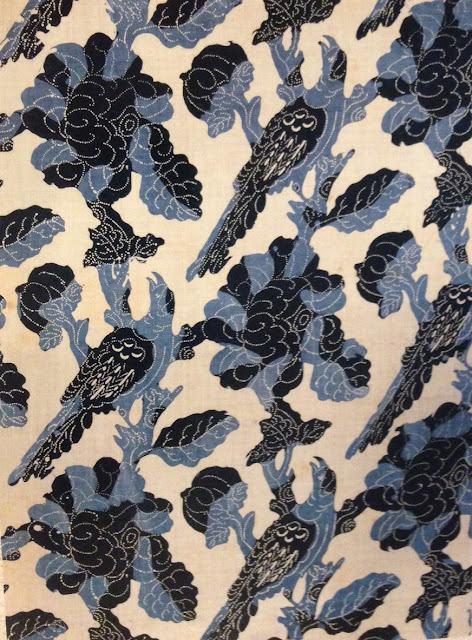 |
| Blue Resist Panel- cotton fabric painted and block printed resist most likely made in India for the American market |
There is a new exhibit at the Met that I had to see and was going to get there no matter what....which means Harper, my new baby, was most likely coming with me. So last week I packed up the stroller, brought the carrier in case the stroller wouldn't be allowed and Harper and I headed to the number 4 train at Barclay's Center up to 86th St stop in Manhattan. I wanted to blog about this exhibit because I know many of us are so busy and may not know what is current at the museums. And with so much in NYC the options are endless.
Interwoven Globe are fabrics from wall hangings to clothing made in between the 14th and 18th centuries. This is when exploration was at it's peak. Most of the fabric was made in India or China for Europe or America markets. Unlike today's global markets, these items were mainly made for and sold to the wealthy. There were wall hangings, carpets, decorative textiles, bed covers and waistcoats. Most of the thread used was silk or metal wrapped thread.
 |
| Palampore - from India made for the Sri Lankan market cotton, paint resist and mordant, dyed 72" x 44" |
 |
| double sided wall hanging from China made for the European market in the second half of the 18th century. This is silk satin and embroidered with silk. |
The above double sided wall hanging was most likely used in a window so art can be seen from the outside and on the inside. This also may have been a substitute for wall paper since it couldn't be produced fast enough for the European market.
By the second half of the 18th century India products were being largely influenced by the west. This was reflected mostly by color and slightly by design. Chintz became popular in the Netherlands being made in India or China.
A few more pieces that caught my eye.
If you are looking for a few hours of inspiration definitely try to make a trip to the museum. And if you have a baby, strollers are allowed (not the double wide ones) and Harper seemed to enjoy looking at all the colors of the fabrics.
Have a great week!
Tracey
http://traceytoole.blogspot.com/
https://www.etsy.com/shop/traceytoole
A few more pieces that caught my eye.
 |
| Fustian with pheasants and exotic flowers. The art is a European interpretation of foreign motifs. Fustian is fabric that is cotton in the warp and linen in the weft This was copperplate printed which became popular in the second half of the 18th century |
 |
| over 7 feet long - from India made for the Japanese market in the 18th century cotton and paint resist, then dyed Sarasa with small rosettes |
If you are looking for a few hours of inspiration definitely try to make a trip to the museum. And if you have a baby, strollers are allowed (not the double wide ones) and Harper seemed to enjoy looking at all the colors of the fabrics.
Have a great week!
Tracey
http://traceytoole.blogspot.com/
https://www.etsy.com/shop/traceytoole

1 comment:
Wonderful fabrics, thanks so much for sharing.
Post a Comment